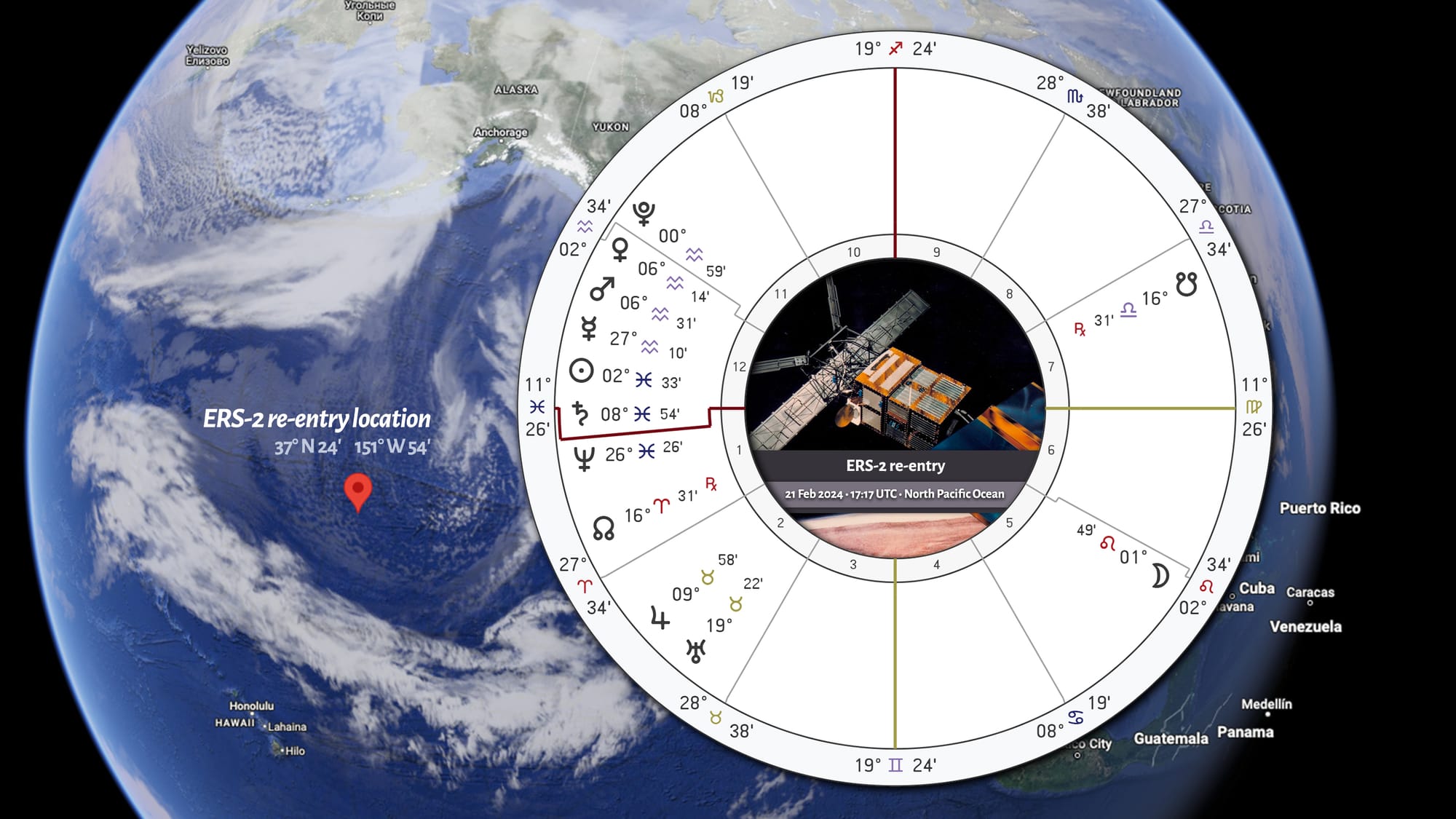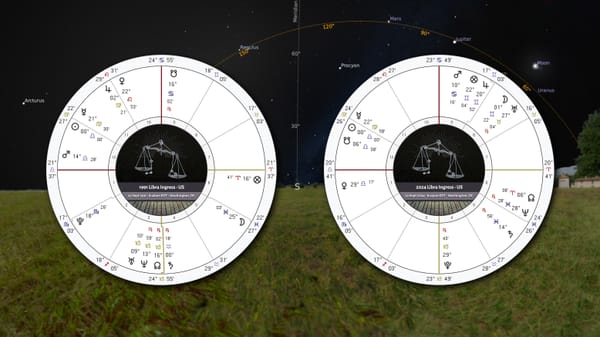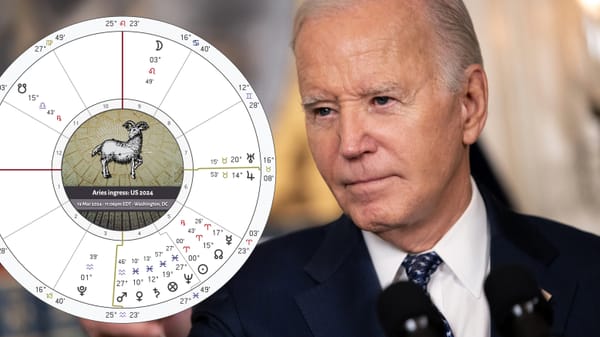Satellite re-entry: revisiting a horary from 1983
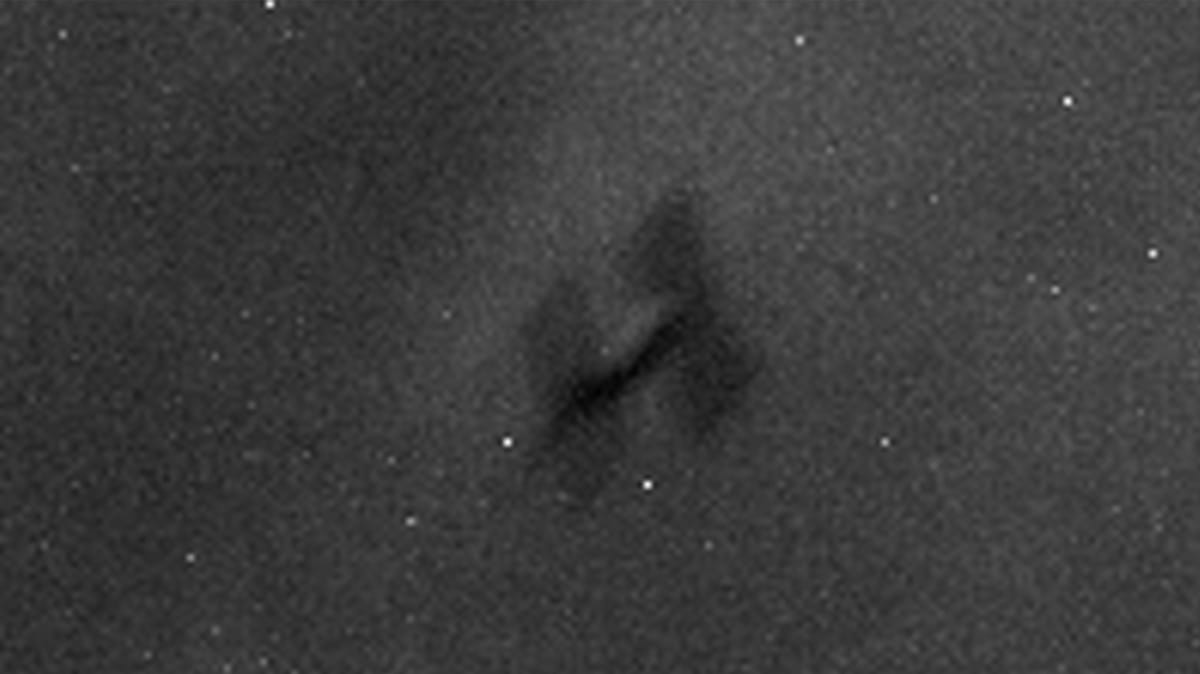
This article generated some discussion on the Skyscript forums: see forum thread.
A satellite set to re-enter earth's atmosphere uncontrollably is anticipated to do so tomorrow, nearly three decades following its launch. The European Space Agency (ESA) has identified the ERS-2 satellite's re-entry window as between February 16 and February 22, 2024, [1] with the most recent predictions pointing to tomorrow as the expected date, give or take 24 hours.
ERS-2, which will likely disintegrate upon re-entry, sending the majority of its fragments to incinerate, was part of the ESA's inaugural program for earth observation from a polar orbit, named the European Remote Sensing (ERS) satellite.
Given the re-entry's "natural" nature, meaning it lacks human guidance, pinpointing the precise timing and location of its descent is deemed impossible by the ESA.
ERS-2 spotted! 📸🛰️
— ESA Operations (@esaoperations) February 19, 2024
The ESA satellite is on a tumbling descent that will lead to its atmospheric reentry and break up this week.
These images of ERS-2 were captured by @heospace for @spacegovuk using cameras on board other satellites.#ERS2reentry pic.twitter.com/GTuubP6apJ
This headline reminded me instantly of a horary judged by Olivia Barclay in her book Horary Astrology Rediscovered (1990), discussed in the chapter titled "The Satellite." This book was one of the first I read on the subject of horary, and some segments of it left a lasting impression. Locating the landing site of Kosmos 1402 with astrology is one such segment.
Let's revisit Olivia's horary from 1983, and see if we can apply some of the same logic to a horary chart related to the imminent descent of ERS-2.
Olivia Barclay and Kosmos 1402
Kosmos 1402, a Soviet reconnaissance satellite, was on the brink of an uncontrollable descent into earth's atmosphere in 1983, several years after its deployment. Part of a secretive military surveillance program, Kosmos 1402 was designed for gathering intelligence from orbit, employing sophisticated sensors to monitor strategic assets globally. As it neared the end of its operational life, authorities and experts closely monitored its trajectory, anticipating its re-entry. Given the satellite's unguided fall from space, there was significant uncertainty surrounding the timing and location of its descent. This event stirred public and governmental concern, as the unpredictable nature of its re-entry posed potential risks, echoing broader anxieties about space debris and the safety of objects returning to earth from orbit.
In her book, Olivia recounts the story and what led her to draw up a horary concerning the satellite's fall:
This is a chart about the satellite that was encircling the Earth in January 1983. As you can see by the planetary positions, the chart was drawn on the evening of 20 January 1983. We had just been told by the television news that nobody knew where it would fall. The Belgians were sitting in concrete bunkers in anticipation. [...] This was predicted with witnesses before the event.
The below summarizes Olivia's documented approach.
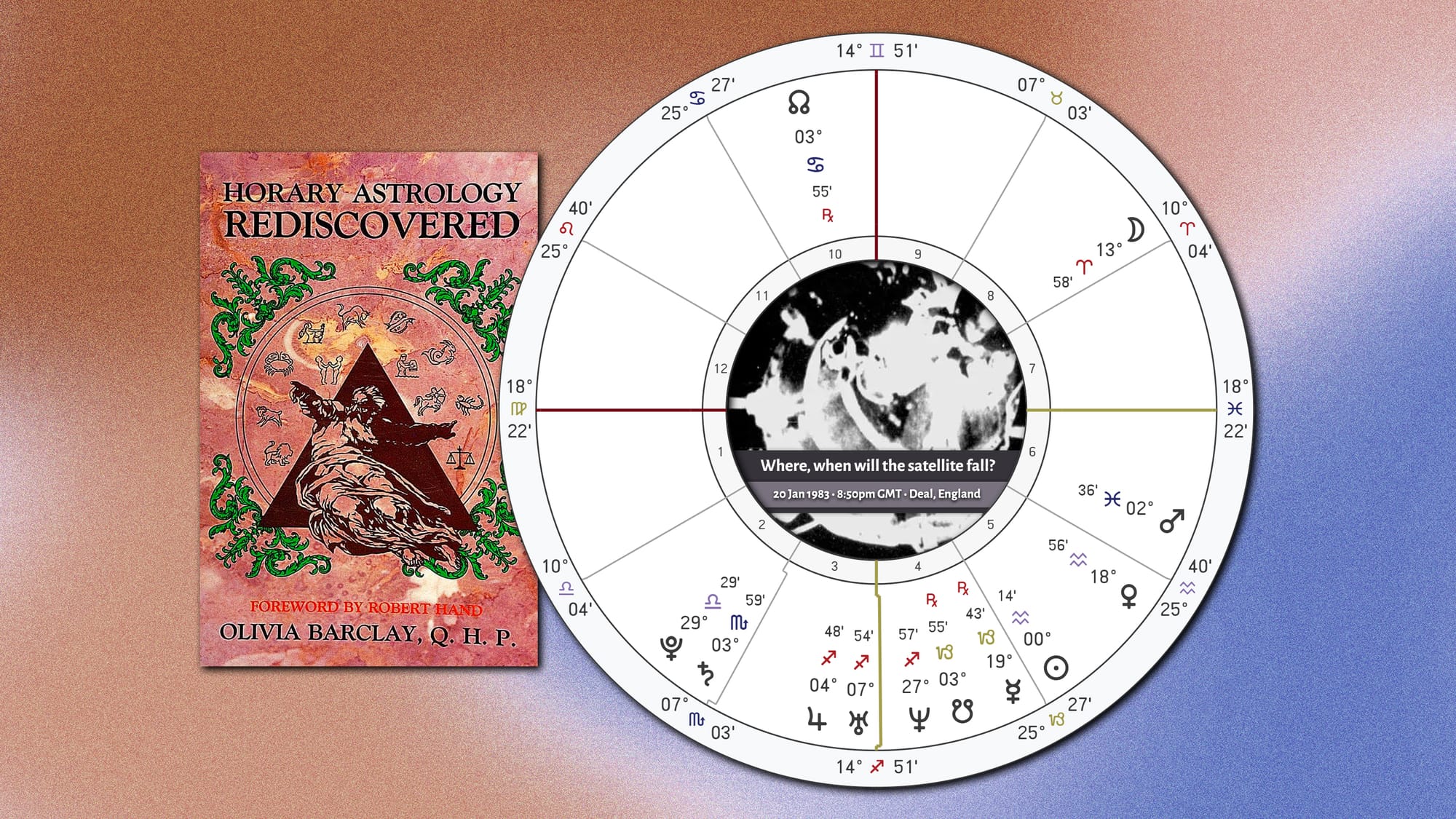
The ascendant represents the querent, but in a question such as this, we might also accord the earth to the ascendant as the vehicle we all travel in. The 7th cusp might then represent boundless space.
Mercury rules the ascendant, and its retrograde status reflects the satellite's return to the earth. In the 4th house, this chart represents the end for Kosmos 1402. Though Olivia didn't note this, I find it appropriate for Mercury to be in the 4th considering this chart reflects an object falling to the surface of the earth.
But where will the satellite return? With the ascendant-ruler in Capricorn, Olivia expected the satellite to crash somewhere associated with that sign. Lilly lists the following: Thrace, Macedon in Greece now Turkey, Albania, Bulgaria, Saxony the southwest part (Germany), the West Indies, Styria (a region in Austria), Orkney Islands, Hesse (Germany), Oxford, Mecklenburg, Cleves, Brandenburg (Germany). Lilly does not make direct reference to India in Christian Astrology, but in her book, Olivia pins Capricorn's symbolism on India. She did not give any detail as to why.
The Moon, Jupiter, Uranus and Neptune are all in fire signs; the Sun, Venus and Pluto in air signs – the expectation was that most of the satellite would burn up upon re-entry. With only one planet in an earth sign (Mercury), Olivia decided the testimonies disinclined land impact. She judged instead that the satellite was more likely to land in water because Mars, dispositor of the Moon and Mercury and ruler of the 8th house, is in Pisces in applying trine to Saturn in Scorpio. Further, Mercury's placement in the 4th house suggests drowning in its own right, as is Mercury's being disposited by Saturn. Neptune, angular in the 4th house, adds to the watery theme.
"Therefore," wrote Olivia, "the evidence points to both India and the ocean: the Indian Ocean." As all of the planets save the Moon are in the northern hemisphere, indications suggest that the satellite will fall in the global north.
Olivia judged that the satellite would fall 5 days after the question was asked, on 25 January 1983. It actually made impact one day sooner, "no doubt because Mercury was retrograde and went to meet the Moon's aspect more quickly, but also the Moon was moving fast," Olivia wrote. It did indeed fall in the Indian Ocean, but near the Tropic of Capricorn (i.e., in the global south).
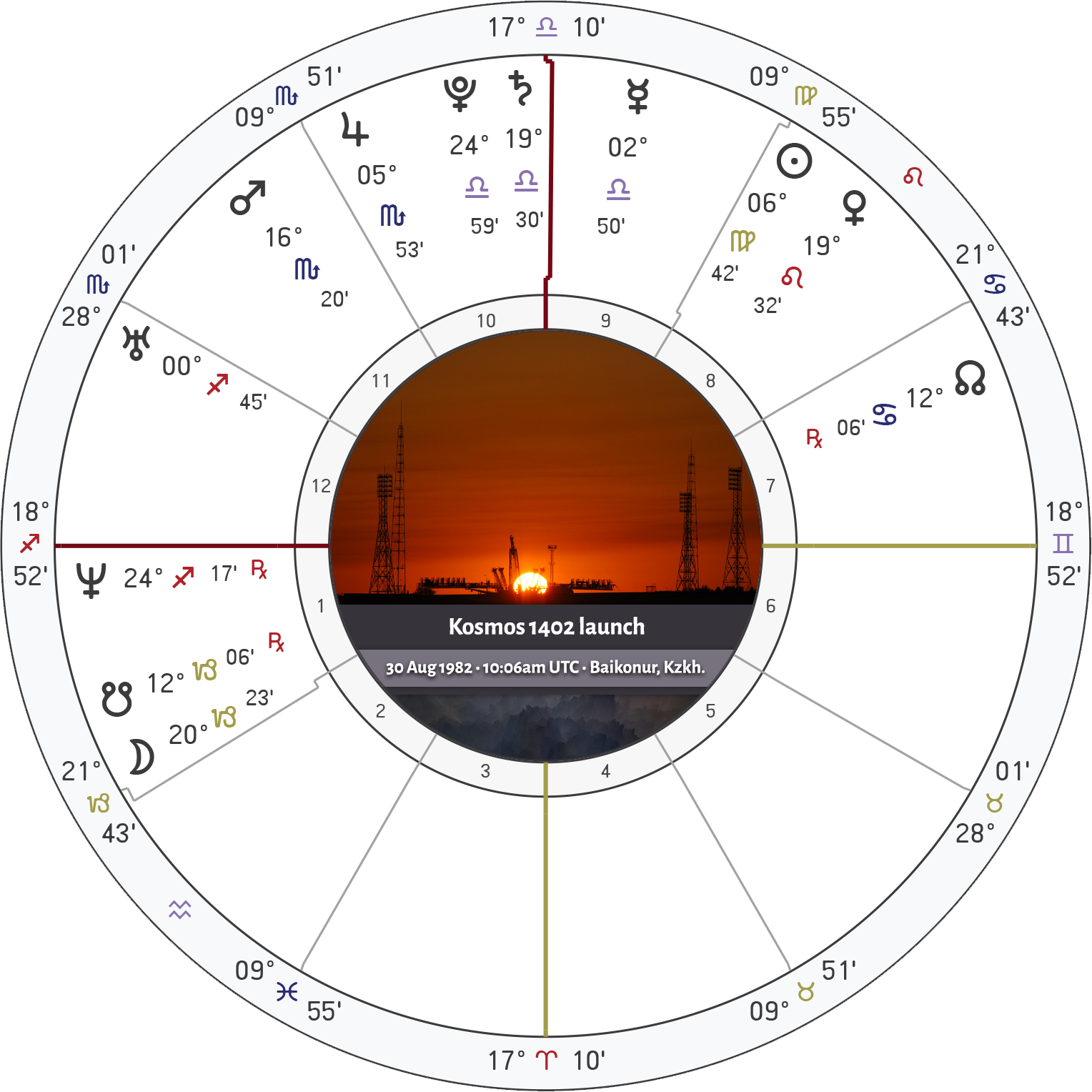
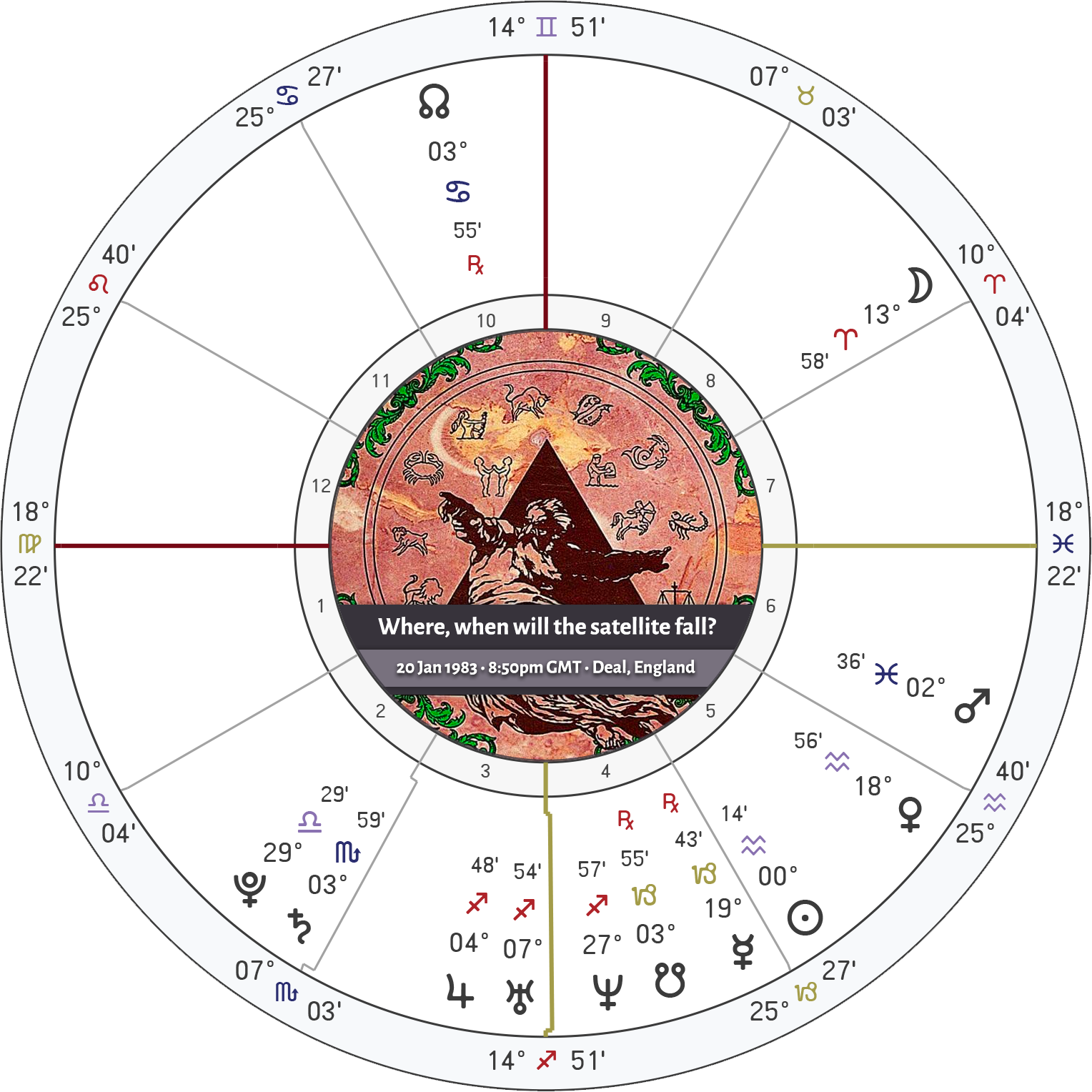
This information would've been harder to come by in 1983, but the advent of internet technology has made it easy to find satellite launch information. Kosmos 1402 was launched from Baikonur, Kazakhstan on 30 August 1982.
Note the connections between the launch chart and Olivia's horary – (a) the launch ascendant became the IC of the horary, showing an arc from launch to destruction; (b) the horary Moon sits on the launch chart's 4th house cusp; (c) the launch ascendant-ruler, Jupiter, was being transited by Saturn in Olivia's horary, and in the horary, Saturn disposited the significator of the satellite by sign; (d) Mercury, ruler of the horary ascendant, was a retrograde transit to the launch chart's Moon at 20° Capricorn.
Me, you, and ERS-2
Sometime late afternoon I learned about ERS-2's descent, and wondered if the time had come for me to put Olivia's approach to the test. I should say that while my approach is sincere, my involvement here is simply for the art of it. I am not stressed about 'getting it right,' but rather exploring the symbolism involved and evaluating the replicability of the methodology used in Olivia's own chart on this theme.
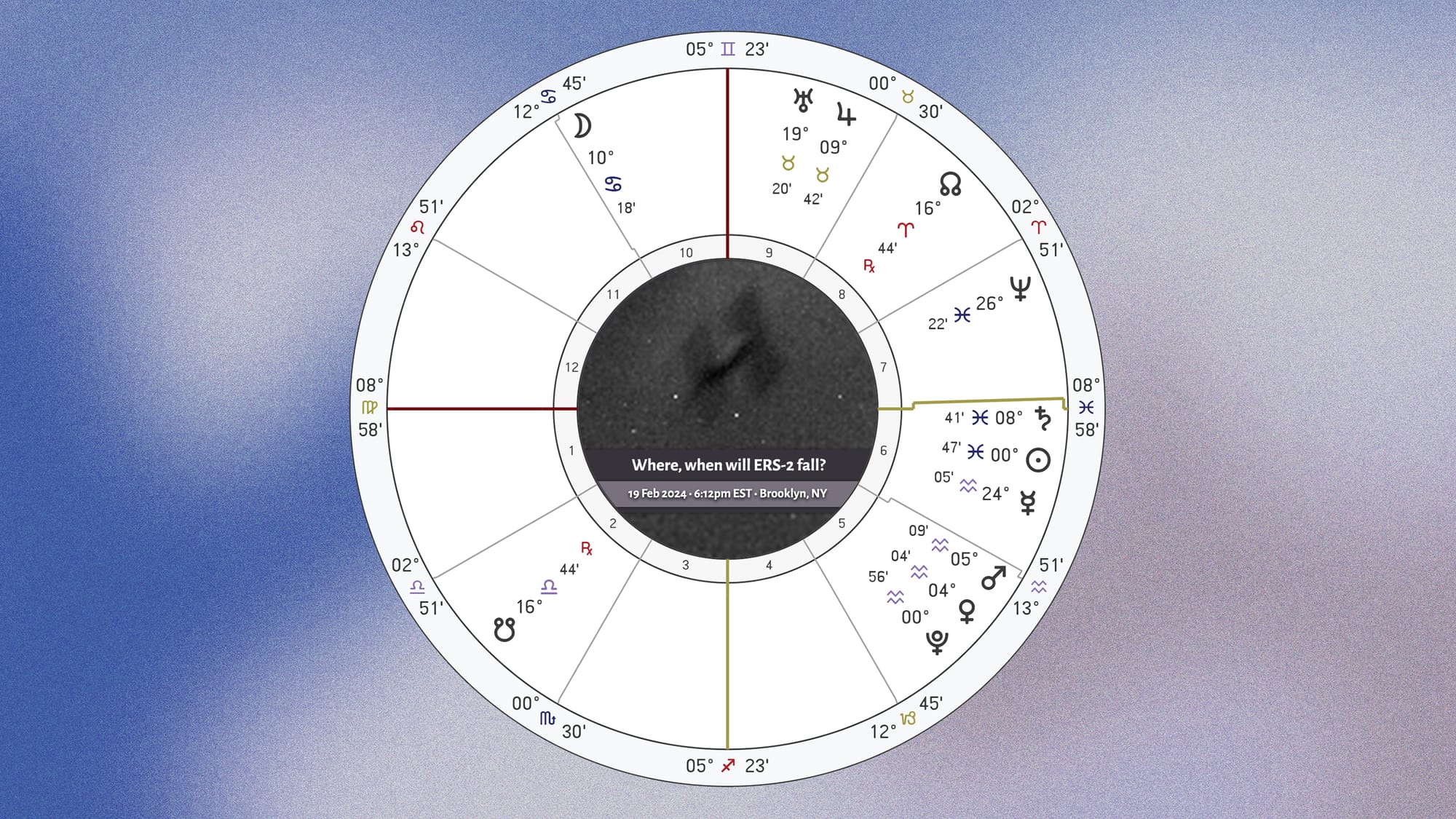
The ascendant is, once again, in Virgo – and our satellite is shown by Mercury at 24° Aquarius in the 6th house. Cadent houses are so named because they fall from the angles ("cadent" comes from the Latin root cadens "falling"). All cadent houses are appropriate for things that are descending or plummeting from great heights. Interestingly, the 6th house falls from the 7th, and the 7th as the western or setting angle is the one we associate with the end of life. The 6th house, then, is the first falling house planets enter after setting or descending into the underworld. ERS-2 was decommissioned in September 2011, and considered a "dead" satellite – appropriate start, I think.
At 24° Aquarius, Mercury is conjunct Deneb Algedi, or the tail of the goat. Capricorn, the sea-goat, is a dual image – its front-half is associated with land, its back with water. With Mercury in a water-associated sign, conjunct the tail of the goat, both luminaries in water signs, and an angular Saturn in Pisces, the satellite should be expected to land in a body of water. Perhaps that isn't too brave a call, though, as roughly 71% of the earth's surface is covered in water.
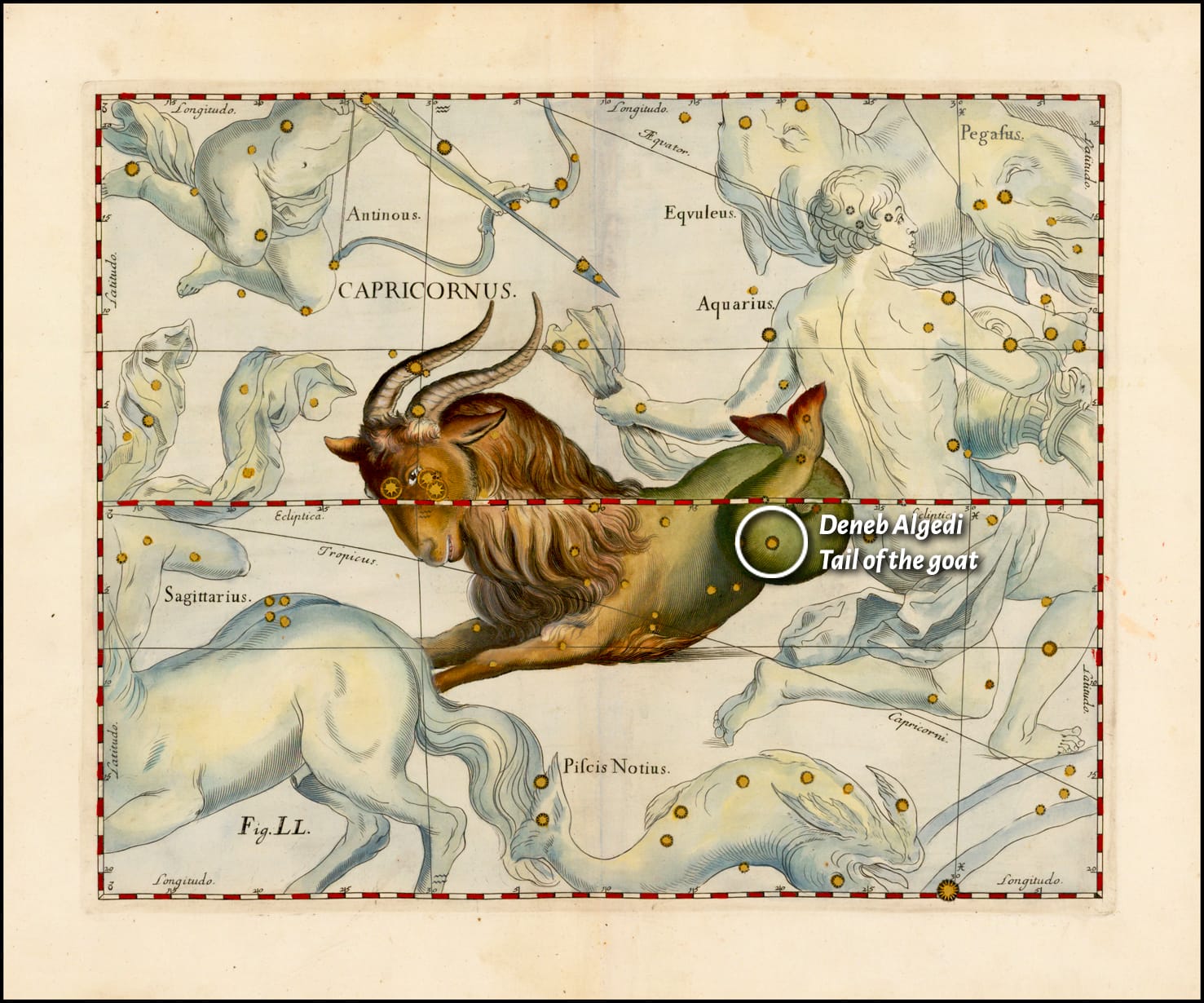
Mercury in Aquarius brings attention to other landscapes besides water. Mountainous regions, especially those marked by extreme cold, certainly fit the sign. Unique to Aquarius is its association with water infrastructure, i.e., structures that extract or redirect the natural flow of groundwater. Al-Biruni writes that this sign describes "Running and standing water, heated bath-water, taverns, brothels, canals and ditches, birds' nests and resorts of aquatic birds" (Elements, 366).
Lilly's list of countries associated with Aquarius include modern central Asia, Croatia, southern Romania, Russia, western and southern regions of Germany, Italy, northern Iran, and the Arabian peninsula. The problem with this list is its limitations: the entries are decidedly Eurocentric, and there's a lot more to the globe than what Lilly could confidently report on in the 17th century.
Some of these locations may be a bit too far to the east if we are to reproduce Olivia's technique faithfully. She suggested that the heavy stacking of northern planets in her horary indicated Kosmos 1402 would make impact in the global north. In my chart, planets are stacked in the western hemisphere. Following Olivia's lead, this points to the global west, from 0° to 180° of terrestrial longitude. This captures western Europe and Africa, North and South America, and the Atlantic, Southern, and Pacific Oceans, as well as the islands found in them.
The trouble is that Olivia was wrong in this particular detail – her satellite fell near the Tropic of Capricorn at 25° S, in contradiction to her expectation that the northern clustering of planets indicated re-entry in the northern hemisphere. Mercury ruled the satellite in Olivia's chart, and was placed in Capricorn, a southern sign. The Moon was in the southern hemisphere – perhaps this is a better point of emphasis. If so, that might give some credence to ERS-2 landing in the western hemisphere, as my chart's Mercury is in Aquarius, a western sign Wherever the satellite lands, it feels most probable that Aquarius would symbolically connect with the crash site.
We are within hours of ERS-2's landing. As the Moon changes sign, it comes upon the opposition of Pluto, Venus, and Mars, and the square of Jupiter. I would be particularly delighted if the satellite made impact as the Moon transited Mercury's term, which begins at 6° Leo 00' and ends at 12° Leo 59', because Venus, Mars, and Jupiter all aspect this term by square or opposition, and each of these planets is themselves placed in terms of Mercury.
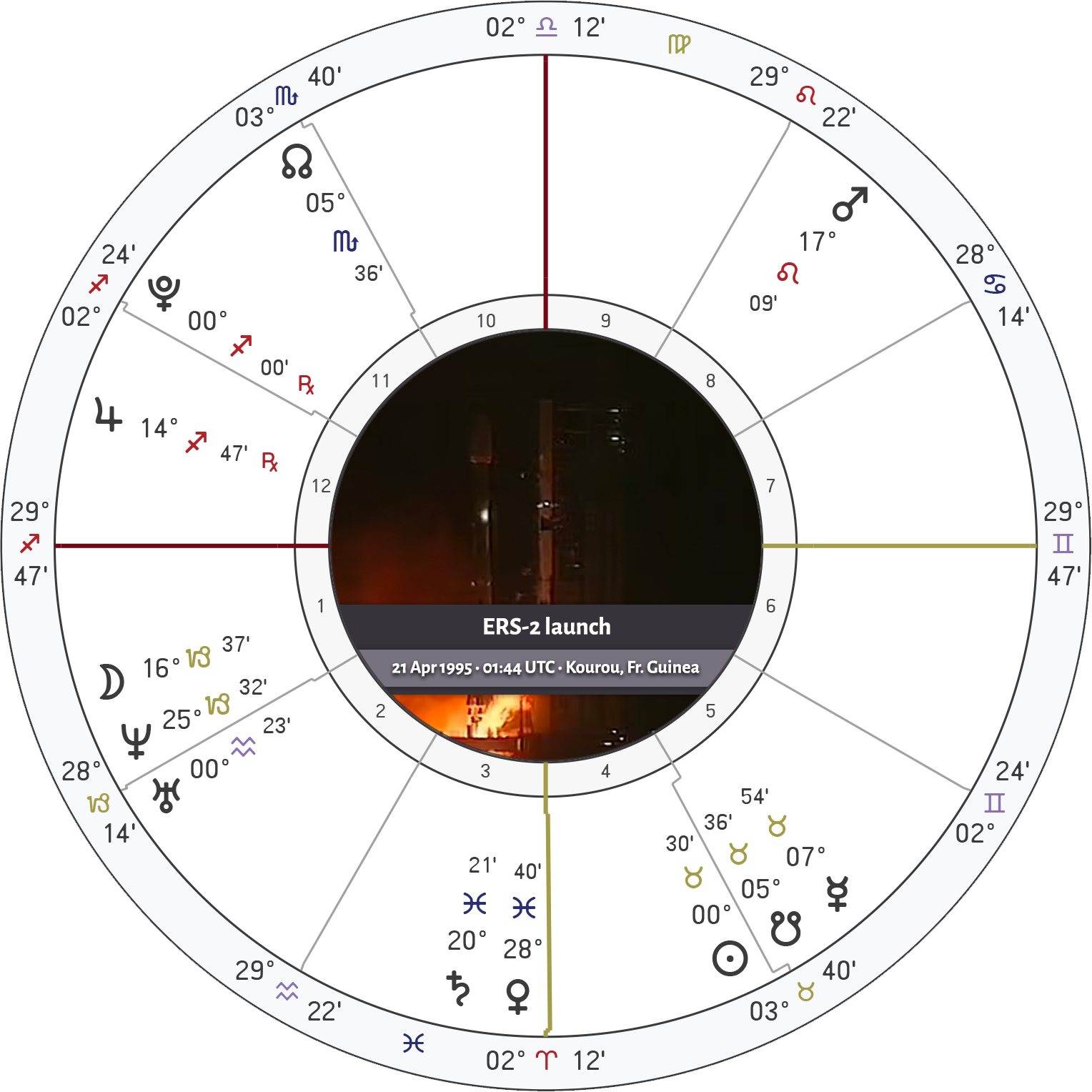
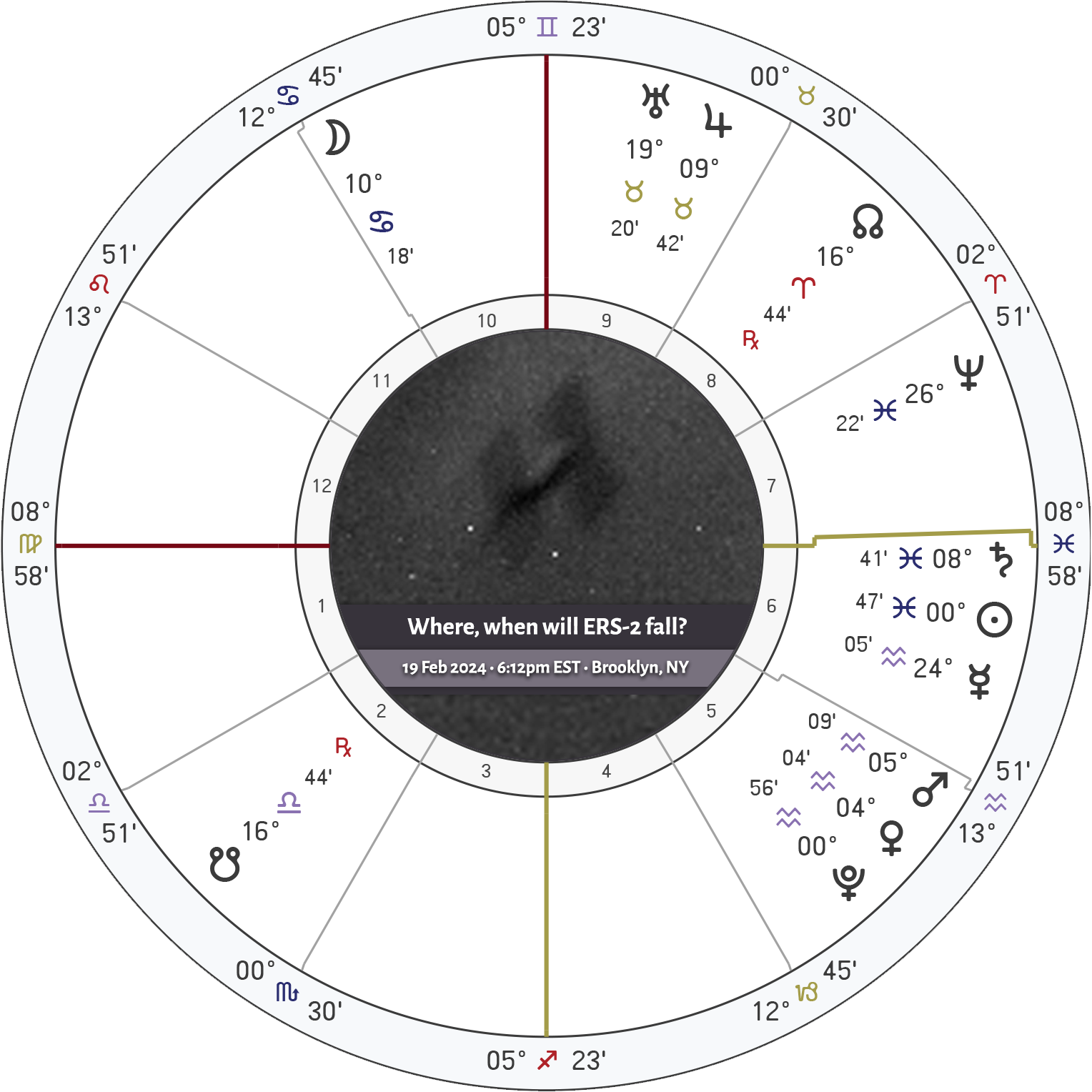
ERS-2 was launched in 1995, and is coming up against its Saturn return. Remembering how Olivia's horary compared to the Kosmos 1402 launch chart, we find familiar themes reflected here. The launch chart's 4th house becomes the 8th house cusp of the horary, and the horary's Moon is in applying opposition to the launch Moon at 16° Capricorn.
It feels a bit beyond my skill to predict where this particular device will fall on earth with the kind of precision Olivia says she delivered. But that's hardly the point – I have enjoyed immensely the opportunity to revisit Olivia's horary from 1983, and to try my hand at a horary of a similar nature.
I will update this article with the crash details once they are available to the public.
Update: ERS-2's actual re-entry
We finally have confirmed re-entry in the North Pacific Ocean between Hawai'i and Alaska (37° N 24', 151° W 54') at 17:17 UTC. A relocated version of my horary puts the Moon on the ascendant in this location, and Saturn just passing over the local meridian.
The satellite did indeed land in the western hemisphere, veering north, which means the angular compass directions were more reliable here than in Olivia's case. Re-entry occurred at 17:17 UTC when the Moon, in the first term of Leo, opposed Venus and Mars across the 6th and 12th house cusps, within degrees of the launch chart's 2nd/8th cusps.
The Sun and Saturn were rising over the ascendant when the satellite landed. ERS-2's launch chart had Sagittarius rising, and ascendant-ruler Jupiter was retrograde at 14° Sagittarius. The transiting midheaven upon re-entry (19° Sagittarius) would've brought that retrograde planet to the local meridian.
